

Space Tourism: How Much Does it Cost & Who's Offering It?
Last Updated: December 17, 2022
Many of us dream of going to space and over 600 people have traveled to space as astronauts in government-funded agencies such as NASA, the European Space Agency, and Roscosmos. But how much does spaceflight cost in today and how is that expected to change in the coming years?
With new advancements in spaceflight technology, the costs of space travel are decreasing, making the dream of spaceflight a little closer for us all.
Evolution of Spaceflight Costs and Technologies
During the space race, the cost of sending something into space averaged between $6,000 to over $25,000 per kg of weight not adjusted for inflation and NASA spent $28 billion to land astronauts on the moon, about $288 billion in today’s dollars.
In recent decades, it has averaged around $10,000 per kg though certain missions have been higher due to other factors including the destination, the size of the rocket, the amount of fuel needed, and the cost of fuel.
After the retirement of the space shuttle program, NASA paid Russia to transport astronauts to the ISS at about $80 million per seat on the Soyuz rocket. NASA’s biggest and newest rocket, the SLS (Space Launch System) which is currently being utilized for the new moon missions including Artemis and Orion, currently costs about $2-4 billion per launch.
But recent years and the addition of private space companies have drastically changed the game. NASA allowed private space companies to develop equipment for missions, including a 2006 partnership with SpaceX under the Commercial Orbital Transportation Services (COTS) program to provide resupply for crew and cargo demonstration contracts to the International Space Station (ISS).
This partnership has continued to flourish over the years with SpaceX successfully launching two NASA astronauts in May 2020 on a Crew Dragon Spacecraft, making SpaceX the first private company to send astronauts to the ISS and the first crewed orbital launch from American soil in 9 years.
With the revolutionary technology of reusable boosters from SpaceX, the cost has plummeted, achieving less than $1,600 per kg with the Falcon Heavy (still totaling more than $100 million per launch) and even a projected cost of under a thousand for their next generation model Star Ship.
These recent innovations are even making SLS the more expensive, less efficient option if SpaceX’s projections continue to progress as expected within margins of error. We shall see how NASA plans to adapt goals in light of this.
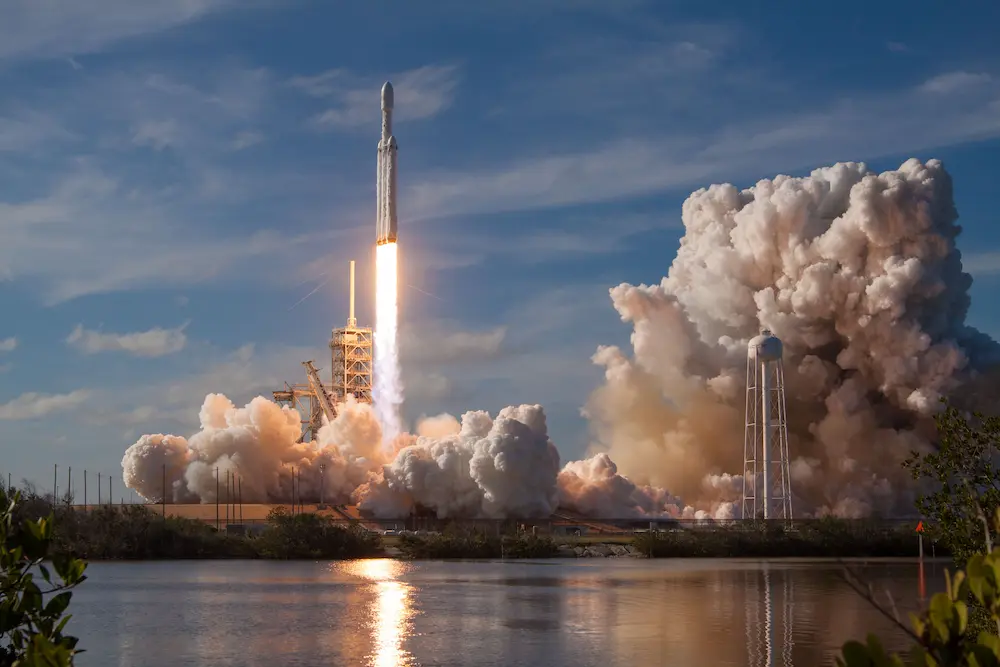
The Falcon Heavy is a cost-effective option for launching payloads into space.
The rise of private space companies
With private space companies, the opportunity for civilians to book a trip to space similar to booking a flight came closer to reality. Dennis Tito was the first private citizen to pay for a trip to space with a trip to the ISS from April 28th to May 6th, 2001 for $20 million dollars. Tito purchased his experience through Space Adventures Inc. which was founded in 1998 and offers a variety of different space experiences. They even acquired Zero Gravity Corporation, NASA’s provider of Reduced Gravity Training (not in space) for its astronauts, in 2008. They offer similar experiences for private individuals starting at about $8,200 as of this publishing (December 2022).
Space Adventures sent seven other space tourists to the ISS through 2009, but due to a number of factors, Space Adventures had to put their ISS offerings on hold until 2021 when they were able to purchase two Soyuz seats due to NASA moving their contract to SpaceX. Space Adventures sent two people to the ISS via the Roscosmos Soyuz rocket in December 2021 and is working on expanding its offerings.
In addition to Elon Musk’s SpaceX, there are a number of other private space companies getting into the commercial spaceflight/ space tourism market, most notably Richard Branson’s Virgin Galactic and Jeff Bezos’s Blue Origins.
Flight Providers & Rates
What are the current rates for commercial spaceflight tickets? What commercial spaceflight trips have already happened? All prices are per person/ per seat.
SpaceX has had the most experience in sending humans to space thanks to its partnership with NASA and Musk has made it clear that he wants to make space travel an option for the public. To date, SpaceX has offered two commercial spaceflight options and has one big one planned for the future:
- SpaceX completed a Multi-Day Orbital Voyage, the first of their new plan to offer private astronaut experiences through their NASA partnership.
- Estimated $55 million for a 3-day stay inside a modified SpaceX Dragon capsule orbiting the Earth at 357 miles (574 km) with three crewmates, sponsored by billionaire Jared Isaacman to raise money for St Jude’s Children’s Hospital
- Partnership between SpaceX and Houston-based Axiom Space Inc.
- $55 million for a 10-day trip to ISS at 408 km with a weeklong (8-day) stay in the orbital lab.
- Expected to continue in 2023
- Axiom plans to build a stand-alone space station to replace the ISS with the first module expected to launch in 2024.
- Steve Aoki: American DJ and record producer
- Everyday Astronaut Tim Dodd: American science communicator, content creator, photographer, and musician
- Yemi A.D.: Czech choreographer, art director and performer
- Rhiannon Adam: Irish photographer
- Karim Iliya: British photographer and filmmaker
- Brendan Hall: American filmmaker and photographer
- Dev Joshi: Indian television actor
- Choi Seung-hyun (stage name: T.O.P.): South Korean rapper, singer, songwriter, record producer, and actor
- Cost is unknown, likely a minimum of $500 million
2. Blue Origin
Blue Origin: currently offers a 100km 12-minute ride to the Karman Line, the recognized boundary between Earth’s atmosphere and outer space; pricing is still unclear and dependent on a variety of factors
- On July 2021, Jeff and Mark Bezos went into space on the New Shepard rocket with Oliver Daemen (who won the trip through an auction bid of around 28 million) and honored guest Wally Funk (a member of Mercury 13, the private program in which women trained to be astronauts but ultimately never went to space)
- Blue Origin has completed 6 commercial space flights as of this publishing. Some “honorable guests” have been invited free of charge, such as Funk and actor William Shatner (Captain Kirk from the original Star Trek). Some have been sponsored or have received special deals due to their nonprofit status.
- $28 million winning auction bid for the first flight ( $19 million was donated)
- $1 million for a board member of a nonprofit
- About $1.25 for a Dude Perfect comedy group crew member, hosted by MoonDAO in August 2022
3. Virgin Galactic Subortbital Joy Ride
Virgin Galactic Subortbital Joy Ride: $450,000 for a 90-minute ride to suborbital space 50km above sea level
- In July 2021, founder Richard Branson flew to the edge of Earth’s atmosphere with two pilots and three other Virgin Galactic employees as the first test of commercial spaceflight for the company
- Each VSS Unity SpaceShipTwo carries up to four passengers
- Expected flights are currently anticipated to begin in 2023
- Includes training accommodations and amenities; launches from New Mexico
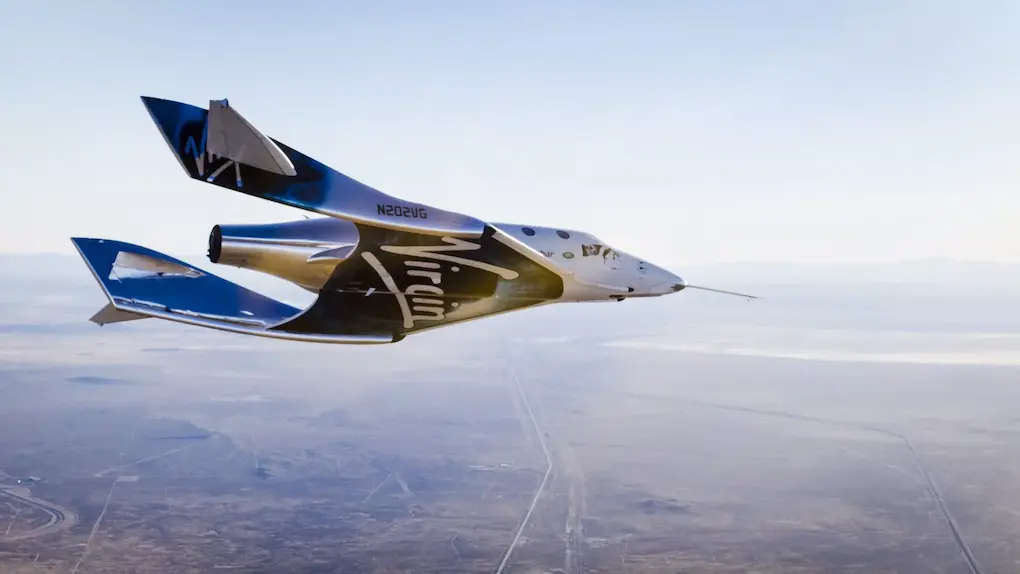
4. Roscosmos/ Space Adventures Customized ISS Trip
Roscosmos/ Space Adventures Customized ISS Trip: $50-60million for a 12-day trip to the ISS at 408 km
- In October 2021 an actress and director shot scenes for the first movie filmed in space
- December 2021 Japanese billionaire Yusaku Maezawa and Yozo Hirano for two days (same billionaire planning to go to the moon with SpaceX)
- With the current situation between Russia and Ukraine, this option is effectively nonexistent currently
5. Space Perspective
Space Perspective: a six-hour balloon ride to space/ the stratosphere on their “Spaceship Neptune” at $125,000
- Rides are currently scheduled to begin by the end of 2024.
- A pressurized capsule will be slowly lifted by a football-field-sized hydrogen-filled balloon 19 miles (30 km) into the stratosphere, about 3 times the altitude of commercial planes.
- The passenger cabin features a bar, bathroom, and windows for sightseeing and is expected to carry 8 passengers and 1 pilot per trip.
6. Aurora Space Station (no longer in development)
Aurora Space Station was supposed to be the world’s first luxury space hotel, offering a 12-day stay for $9.5 million allowing them to free float, observe space and earth, practice hydroponics and play in a hologram deck, but they shut down operations and refunded all deposits in March 2021. They received a lot of media attention and therefore are noted here due to that notoriety.
Conclusion: the current cost of flying to space
Currently, it is only available to those who can spend an average of $250,000 to $500,000 for suborbital trips (about a fifteen-minute ride to the edge of space and back) or flights to actual orbit at more than $50 million per seat (though typically a longer trip than 15 minutes).
It could be free/ discounted if you can find a sponsor, often for nonprofit/ charity purposes, or if you are someone of notoriety that can help spread the company’s mission.
Waitlists are available for most offerings, with a deposit, with many stretching years into the future, which might end up helping you have a spot at a more reasonable price in the future if you can save up.
Many companies are looking to provide extended stay options on private space stations in the future, similar to how you might book a flight somewhere and stay in a hotel for a few days. Again, for the immediate future, this is estimated to cost tens of millions of dollars. The biggest portion of the cost would be launching them, though it is still estimated that a couple million dollars will be needed to cover the expenses of your stay while you are on the space station, whether that is included in the ticket price or added on top of that.
Many companies are hopeful they can eventually price a trip to space down to $100,000 but that will likely take some time, even with the cost-saving measures of reusable boosters. Many forms of recent technology have evolved exponentially in recent years and with dropping price rates as well. Just as plane travel was originally prohibitively expensive, but has now become fairly reasonable for the average consumer, the hope is that the same will eventually happen with space tourism, but we will have to see how long that takes.
While the possibility of going to space is still out of reach for many of us, hopefully, the advancements in recent years and those yet to come will help to continually lower the costs of going to space, just as has occurred in many other fields. This author, for one, truly hopes that the interest of the elite who are currently able to participate in these offerings will spur research and development, not just of space tourism but space exploration in general, to help fuel a quicker journey to space access for all

Written by Sarah Hoffschwelle
Sarah Hoffschwelle is a freelance writer who covers a combination of topics including astronomy, general science and STEM, self-development, art, and societal commentary. In the past, Sarah worked in educational nonprofits providing free-choice learning experiences for audiences ages 2-99. As a lifelong space nerd, she loves sharing the universe with others through her words. She currently writes on Medium at https://medium.com/@sarah-marie and authors self-help and children’s books.
Wow! There's more to read 🚀
This page is part of our collection of articles about astronauts . If you enjoyed the read, then you’ll love the following articles.

How much do astronauts get paid?
The requirements to become an astronaut are extremely rigorous. Does their salary match the difficulty of their profession?
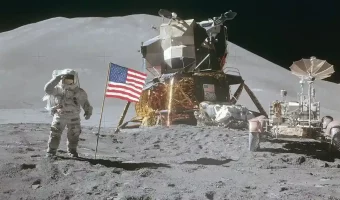
How many flags are on the Moon? The up-to-date list
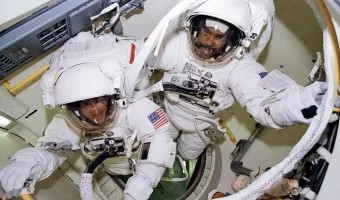
What are the different types of astronauts suit?

How do astronauts train for zero-gravity environments?
Space Tourism: Can A Civilian Go To Space?

2021 has been a busy year for private space tourism: overall, more than 15 civilians took a trip to space during this year. In this article, you will learn more about the space tourism industry, its history, and the companies that are most likely to make you a space tourist.
What is space tourism?
Brief history of space tourism, space tourism companies, orbital and suborbital space flights, how much does it cost for a person to go to space, is space tourism worth it, can i become a space tourist, why is space tourism bad for the environment.
Space tourism is human space travel for recreational or leisure purposes . It’s divided into different types, including orbital, suborbital, and lunar space tourism.
However, there are broader definitions for space tourism. According to the Space Tourism Guide , space tourism is a commercial activity related to space that includes going to space as a tourist, watching a rocket launch, going stargazing, or traveling to a space-focused destination.
The first space tourist was Dennis Tito, an American multimillionaire, who spent nearly eight days onboard the International Space Station in April 2001. This trip cost him $20 million and made Tito the first private citizen who purchased his space ticket. Over the next eight years, six more private citizens followed Tito to the International Space Station to become space tourists.
As space tourism became a real thing, dozens of companies entered this industry hoping to capitalize on renewed public interest in space, including Blue Origin in 2000 and Virgin Galactic in 2004. In the 2000s, space tourists were limited to launches aboard Russian Soyuz aircraft and only could go to the ISS. However, everything changed when the other players started to grow up on the market. There are now a variety of destinations and companies for travels to space.
There are now six major space companies that are arranging or planning to arrange touristic flights to space:
- Virgin Galactic;
- Blue Origin;
- Axiom Space;
- Space Perspective.
While the first two are focused on suborbital flights, Axiom and Boeing are working on orbital missions. SpaceX, in its turn, is prioritizing lunar tourism in the future. For now, Elon Musk’s company has allowed its Crew Dragon spacecraft to be chartered for orbital flights, as it happened with the Inspiration4 3-day mission . Space Perspective is developing a different balloon-based system to carry customers to the stratosphere and is planning to start its commercial flights in 2024.
Orbital and suborbital flights are very different. Taking an orbital flight means staying in orbit; in other words, going around the planet continually at a very high speed to not fall back to the Earth. Such a trip takes several days, even a week or more. A suborbital flight in its turn is more like a space hop — you blast off, make a huge arc, and eventually fall back to the Earth, never making it into orbit. A flight duration, in this case, ranges from 2 to 3 hours.
Here is an example: a spaceflight takes you to an altitude of 100 km above the Earth. To enter into orbit — make an orbital flight — you would have to gain a speed of about 28,000 km per hour (17,400 mph) or more. But to reach the given altitude and fall back to the Earth — make a suborbital flight — you would have to fly at only 6,000 km per hour (3,700 mph). This flight takes less energy, less fuel; therefore, it is less expensive.
- Virgin Galactic: $250,000 for a 2-hour suborbital flight at an altitude of 80 km;
- Blue Origin: approximately $300,000 for 12 minutes suborbital flight at an altitude of 100 km;
- Axiom Space: $55 million for a 10-day orbital flight;
- Space Perspective: $125,000 for a 6-hour flight to the edge of space (32 km above the Earth).
The price depends, but remember that suborbital space flights are always cheaper.
What exactly do you expect from a journey to space? Besides the awesome impressions, here is what you can experience during such a trip:
- Weightlessness . Keep in mind that during a suborbital flight you’ll get only a couple of minutes in weightlessness, but it will be truly fascinating .
- Space sickness . The symptoms include cold sweating, malaise, loss of appetite, nausea, fatigue, and vomiting. Even experienced astronauts are not immune from it!
- G-force . 1G is the acceleration we feel due to the force of gravity; a usual g-force astronauts experience during a rocket launch is around 3gs. To understand how a g-force influences people , watch this video.
For now, the most significant barrier for space tourism is price. But air travel was also once expensive; a one-way ticket cost more than half the price of a new car . Most likely, the price for space travel will reduce overtime as well. For now, you need to be either quite wealthy or win in a competition, as did Sian Proctor, a member of Inspiration4 mission . But before spending thousands of dollars on space travel, here is one more fact you might want to consider.
Rocket launches are harmful to the environment in general. During the burning of rocket fuels, rocket engines release harmful gases and soot particles (also known as black carbon) into the upper atmosphere, resulting in ozone depletion. Think about this: in 2018 black-carbon-producing rockets emitted about the same amount of black carbon as the global aviation industry emits annually.
However, not all space companies use black carbon for fuel. Blue Origin’s New Shepard rocket has a liquid hydrogen-fuelled engine: hydrogen doesn’t emit carbon but simply turns into water vapor when burning.
The main reason why space tourism could be harmful to the environment is its potential popularity. With the rising amount of rocket launches the carbon footprint will only increase — Virgin Galactic alone aims to launch 400 of these flights annually. Meanwhile, the soot released by 1,000 space tourism flights could warm Antarctica by nearly 1°C !
Would you want to become a space tourist? Let us know your opinion on social media and share the article with your friends, if you enjoyed it! Also, the Best Mobile App Awards 2021 is going on right now, and we would very much appreciate it if you would vote for our Sky Tonight app . Simply tap "Vote for this app" in the upper part of the screen. No registration is required!
MIT Technology Review
- Newsletters
Space is all yours—for a hefty price
Commercial spaceflight is now officially a thing. But is it a transcendent opportunity for the masses, or just another way for rich people to show off?
- Adam Mann archive page

Private citizens have been buying their way into the heavens for decades. In the 1980s, McDonnell Douglas engineer Charles Walker became the first nongovernment individual to fly in space when his company bought him a seat on three NASA space shuttle missions. In 2001, American entrepreneur Dennis Tito dished out a reported $20 million to fly on a Russian Soyuz rocket to the International Space Station (ISS) and spend eight days floating in microgravity.
But beyond those few flights, nothing much happened.
At least not until last year. After decades of development and several serious accidents, three companies—SpaceX, Blue Origin, and Virgin Galactic—launched their first tourist flights in 2021. William Shatner rode a Blue Origin vehicle to the edge of space in October. Former NFL star and Good Morning America host Michael Strahan took a similar ride in December. Even NASA, which was once hostile to space tourism, has come around and released a pricing policy for private astronaut missions, offering to bring someone to orbit for around $55 million.
Okay, so it’s a new era—but what does it mean? Do these forays represent a future in which even the average person might book a celestial flight and bask in the splendor of Earth from above? Or is this just another way for the ultrawealthy to flash their cash while simultaneously ignoring and exacerbating our existential problems down on the ground? Nearly all those 2021 escapades were the result of efforts by three billionaires: Elon Musk, Jeff Bezos, and Richard Branson. Branson is a mere single-digit billionaire, whereas Bezos and Musk have wealth measured in the hundreds of billions.
“The greatly undue influence of wealth in this country—to me that’s at the heart of my issues with space tourism as it’s unfolding,” says Linda Billings, a communications researcher who consults for NASA and has written about the societal impacts of spaceflight for more than 30 years. “We are so far away from making this available to your so-called average person.”
Each spot on Virgin’s suborbital spaceplane, the cheapest way to space at the moment, will set somebody back $450,000. A single seat on Blue Origin’s initial suborbital launch sold at auction for $28 million, and the undisclosed price tag of SpaceX’s all-civilian Inspiration4 mission, which spent three days in orbit before splashing down off the coast of Florida, has been estimated at $50 million per passenger.
Not only are such flights ridiculously far out of financial reach for the average person, says Billings, but they aren’t achieving any real goals—far from ideal given our terrestrial problems of inequality, environmental collapse, and a global pandemic. “We’re not really learning anything,” she says. “There doesn’t seem to be a whole lot of thought or conscience in the people engaging in these space tourism missions.”
Laura Forczyk, owner of the space consulting firm Astralytical, thinks it’s misguided to focus strictly on the money aspect. “The narrative [last year] was billionaires in space, but it’s so much more than that,” says Forczyk, who wrote the book Becoming Off-Worldly , published in January, in which she interviewed both government and private astronauts about why they go to space.
Forczyk sees the flights as great opportunities to conduct scientific experiments. All three of the commercial tourist companies have carried research projects in the past, studying things like fluid dynamics, plant genetics, and the human body’s reaction to microgravity. And yes, the rich are the target audience, but the passengers on SpaceX’s Inspiration4 included artist and scientist Sian Proctor and data engineer Chris Sembroski, who won their tickets through contests, as well as St. Jude Children’s Research Hospital ambassador Hayley Arceneaux (the trip helped her raise $200 million in donations for the hospital). Blue Origin gave free trips to aviation pioneer Wally Funk, who as a woman had been barred from becoming an Apollo astronaut, and NASA astronaut Alan Shepard’s daughter Laura.
Forczyk also cites Iranian space tourist Anousheh Ansari, who flew to the ISS in 2006. “She talked about how she grew up in a war zone in Iran, and how [the flight] helped her see the world as interconnected,” Forczyk says.
Billings thinks the value of such testimonials is pretty low. “All these people are talking to the press about how wonderful the experience was,” she says. “But to listen to someone else tell you about how exciting it was to climb Mt. Everest doesn’t convey the actual experience.”
As with an Everest trek, there’s the risk of death to consider. Historically, spaceflight has had a fatality rate of just under 4%—roughly 266,000 times greater than for commercial airplanes. Virgin suffered two major disasters during testing, killing a total of four employees and injuring four more. “A high-profile accident will come; it’s inevitable,” says Forczyk. But even that, she predicts, won’t end space tourism. People continue to climb Everest, she notes, despite the danger.
Another question is how space tourism might affect the planet. A 90-minute jaunt on Virgin Galactic’s suborbital spaceplane is roughly as polluting as a 10-hour transatlantic flight. Other calculations suggest that a rocket launch can produce 50 to 75 tons of carbon dioxide per passenger, compared with just a few tons per passenger from a commercial airplane.
Experts warn that even Blue Origin’s New Shepard, which burns hydrogen and oxygen and emits water, could affect the climate since its combustion products are injected high into the stratosphere, where their ultimate impact has yet to be understood.
The Federal Aviation Administration oversees all spaceflight in the US and might strengthen safety and environmental regulations. The agency currently has a moratorium on new regulations until 2023, which was designed to give the nascent industry time to develop before legislators came in with too much red tape. But few lawmakers or citizens are clamoring for more regulation.
“There are a lot of other things for people to worry about than whether or not only billionaires get to fly in space,” says Marcia Smith, the founder and editor of the news website SpacePolicyOnline.com, which covers space programs around the world.
Nobody has yet fully articulated a compelling reason to spend enormous sums on private spaceflight. It may have incidental value for science and engineering, or offer a small number of people a sense of transcendence.
But at the moment, it seems we do it mainly because we think it’s cool.
Keep Reading
Most popular.

What is AI?
Everyone thinks they know but no one can agree. And that’s a problem.
- Will Douglas Heaven archive page

Happy birthday, baby! What the future holds for those born today
An intelligent digital agent could be a companion for life—and other predictions for the next 125 years.
- Kara Platoni archive page

What are AI agents?
The next big thing is AI tools that can do more complex tasks. Here’s how they will work.
- Melissa Heikkilä archive page

This researcher wants to replace your brain, little by little
The US government just hired a researcher who thinks we can beat aging with fresh cloned bodies and brain updates.
- Antonio Regalado archive page
Stay connected
Get the latest updates from mit technology review.
Discover special offers, top stories, upcoming events, and more.
Thank you for submitting your email!
It looks like something went wrong.
We’re having trouble saving your preferences. Try refreshing this page and updating them one more time. If you continue to get this message, reach out to us at [email protected] with a list of newsletters you’d like to receive.
- Share full article
Advertisement
Supported by
The Future of Space Tourism Is Now. Well, Not Quite.
From zero-pressure balloon trips to astronaut boot camps, reservations for getting off the planet — or pretending to — are skyrocketing. The prices, however, are still out of this world.

By Debra Kamin
Ilida Alvarez has dreamed of traveling to space since she was a child. But Ms. Alvarez, a legal-mediation firm owner, is afraid of flying, and she isn’t a billionaire — two facts that she was sure, until just a few weeks ago, would keep her fantasy as out of reach as the stars. She was wrong.
Ms. Alvarez, 46, and her husband, Rafael Landestoy, recently booked a flight on a 10-person pressurized capsule that — attached to a massive helium-filled balloon — will gently float to 100,000 feet while passengers sip champagne and recline in ergonomic chairs. The reservation required a $500 deposit; the flight itself will cost $50,000 and last six to 12 hours.
“I feel like it was tailor-made for the chickens like me who don’t want to get on a rocket,” said Ms. Alvarez, whose flight, organized by a company called World View , is scheduled to depart from the Grand Canyon in 2024.
Less than a year after Jeff Bezos and Richard Branson kicked off a commercial space race by blasting into the upper atmosphere within weeks of each other last summer, the global space tourism market is skyrocketing, with dozens of companies now offering reservations for everything from zero-pressure balloon trips to astronaut boot camps and simulated zero-gravity flights. But don’t don your spacesuit just yet. While the financial services company UBS estimates the space travel market will be worth $3 billion by 2030, the Federal Aviation Administration has yet to approve most out-of-this-world trips, and construction has not started on the first space hotel. And while access and options — not to mention launchpads — are burgeoning, space tourism remains astronomically expensive for most.
First, what counts as space travel?
Sixty miles (about 100 kilometers) above our heads lies the Kármán line, the widely accepted aeronautical boundary of the earth’s atmosphere. It’s the boundary used by the Féderátion Aéronautique Internationale, which certifies and controls global astronautical records. But many organizations in the United States, including the F.A.A. and NASA, define everything above 50 miles to be space.
Much of the attention has been focused on a trio of billionaire-led rocket companies: Mr. Bezos’ Blue Origin , whose passengers have included William Shatner; Mr. Branson’s Virgin Galactic , where tickets for a suborbital spaceflight start at $450,000; and Elon Musk’s SpaceX , which in September launched an all-civilian spaceflight, with no trained astronauts on board. Mr. Branson’s inaugural Virgin Galactic flight in 2021 reached about 53 miles, while Blue Origin flies above the 62-mile mark. Both are eclipsed by SpaceX, whose rockets charge far deeper in to the cosmos, reaching more than 120 miles above Earth.
Balloons, like those operated by World View, don’t go nearly as high. But even at their maximum altitude of 18 or 19 miles, operators say they float high enough to show travelers the curvature of the planet, and give them a chance to experience the overview effect — an intense perspective shift that many astronauts say kicks in when you view Earth from above.
Now, how to get there …
Blue Origin and Virgin Galactic, which are both licensed for passenger space travel by the F.A.A., are open for ticket sales. (Blue Origin remains mum on pricing.) Both companies currently have hundreds or even thousands of earthlings on their wait lists for a whirl to the edge of space. SpaceX charges tens of millions of dollars for its further-reaching flights and is building a new facility in Texas that is currently under F.A.A. review.
Craig Curran is a major space enthusiast — he’s held a reserved seat on a Virgin Galactic flight since 2011 — and the owner of Deprez Travel in Rochester, N.Y. The travel agency has a special space travel arm, Galactic Experiences by Deprez , through which Mr. Curran sells everything from rocket launch tickets to astronaut training.
Sales in the space tourism space, Mr. Curran acknowledges, “are reasonably difficult to make,” and mostly come from peer-to-peer networking. “You can imagine that people who spend $450,000 to go to space probably operate in circles that are not the same as yours and mine,” he said.
Some of Mr. Curran’s most popular offerings include flights where you can experience the same stomach-dropping feeling of zero gravity that astronauts feel in space, which he arranges for clients via chartered, specialized Boeing 727s that are flown in parabolic arcs to mimic being in space. Operators including Zero G also offer the service; the cost is around $8,200.
You can almost count the number of completed space tourist launches on one hand — Blue Origin has had four; SpaceX, two. Virgin Galactic, meanwhile, on Thursday announced the launch of its commercial passenger service, previously scheduled for late 2022, was delayed until early 2023. Many of those on waiting lists are biding their time before blastoff by signing up for training. Axiom Space, which contracts with SpaceX, currently offers NASA-partnered training at Houston’s Johnson Space Center. Virgin Galactic, which already offers a “customized Future Astronaut Readiness program” at its Spaceport America facility in New Mexico, is also partnering with NASA to build a training program for private astronauts.
Would-be space tourists should not expect the rigor that NASA astronauts face. Training for Virgin Galactic’s three-hour trips is included in the cost of a ticket and lasts a handful of days; it includes pilot briefings and being “fitted for your bespoke Under Armour spacesuit and boots,” according to its website.
Not ready for a rocket? Balloon rides offer a less hair-raising celestial experience.
“We go to space at 12 miles an hour, which means that it’s very smooth and very gentle. You’re not rocketing away from earth,” said Jane Poynter, a co-founder and co-chief executive of Space Perspective , which is readying its own touristic balloon spaceship, Spaceship Neptune. If all goes according to plan, voyages are scheduled to begin departing from Florida in 2024, at a cost of $125,000 per person. That’s a fraction of the price tag for Blue Origin and Virgin Galactic, but still more than double the average annual salary of an American worker.
Neither Space Perspective nor World View has the required approval yet from the F.A.A. to operate flights.
Unique implications
Whether a capsule or a rocket is your transport, the travel insurance company battleface launched a civilian space insurance plan in late 2021, a direct response, said chief executive Sasha Gainullin, to an increase in space tourism interest and infrastructure. Benefits include accidental death and permanent disablement in space and are valid for spaceflights on operators like SpaceX, Blue Origin and Virgin Galactic, as well as on stratospheric balloon rides. They’ve had many inquiries, Mr. Gainullin said, but no purchases just yet.
“Right now it’s such high-net-worth individuals who are traveling to space, so they probably don’t need insurance,” he said. “But for quote-unquote regular travelers, I think we’ll see some takeups soon.”
And as the industry grows, so perhaps will space travel’s impact on the environment. Not only do rocket launches have immense carbon footprints, even some stratospheric balloon flights have potentially significant implications: World View’s balloons are powered by thousands of cubic meters of helium, which is a limited resource . But Ted Parson, a professor of environmental law at the University of California, Los Angeles, said that space travel’s environmental impact is still dwarfed by civil aviation. And because space travel is ultra-niche, he believes it’s likely to stay that way.
“Despite extensive projections, space tourism is likely to remain a tiny fraction of commercial space exploration,” he said. “It reminds me of tourism on Mt. Everest. It’s the indulgence of very rich people seeking a transcendent, once-in-a-lifetime experience, and the local environmental burden is intense.”
Stay a while?
In the future, space enthusiasts insist, travelers won’t be traveling to space just for the ride. They’ll want to stay a while. Orbital Assembly Corporation, a manufacturing company whose goal is to colonize space, is currently building the world’s first space hotels — two ring-shaped properties that will orbit Earth, called Pioneer Station and Voyager Station. The company, quite optimistically, projects an opening date of 2025 for Pioneer Station, with a capacity of 28 guests. The design for the larger Voyager Station , which they say will open in 2027, promises villas and suites, as well as a gym, restaurant and bar. Both provide the ultimate luxury: simulated gravity. Axiom Space , a space infrastructure company, is currently building the world’s first private space station; plans include Philippe Starck-designed accommodations for travelers to spend the night.
Joshua Bush, chief executive of travel agency Avenue Two Travel , has sold a handful of seats on upcoming Virgin Galactic flights to customers. The market for space travel (and the sky-high prices that come with it), he believes, will evolve much like civilian air travel did.
“In the beginning of the 20th century, only very affluent people could afford to fly,” he said. “Just as we have Spirit and Southwest Airlines today, there will be some sort of equivalent of that in space travel, too. Hopefully within my lifetime.”

52 Places for a Changed World
The 2022 list highlights places around the globe where travelers can be part of the solution.
Follow New York Times Travel on Instagram , Twitter and Facebook . And sign up for our weekly Travel Dispatch newsletter to receive expert tips on traveling smarter and inspiration for your next vacation. Dreaming up a future getaway or just armchair traveling? Check out our 52 Places for a Changed World for 2022.
What’s Up in Space and Astronomy
Keep track of things going on in our solar system and all around the universe..
Never miss an eclipse, a meteor shower, a rocket launch or any other 2024 event that’s out of this world with our space and astronomy calendar .
A speeding star is traveling through the Milky Way at around a million miles an hour. It could be moving fast enough to break free from the gravitational clutches of the galaxy .
In 1924, a radio receiver built for the battlefields of World War I tested the idea that humans were not alone in the solar system, heralding a century of searches for extraterrestrial life .
A study adds strong evidence to the hypothesis that the asteroid that killed the dinosaurs came from a family of objects that originally formed well beyond the orbit of the planet Jupiter.
Is Pluto a planet? And what is a planet, anyway? Test your knowledge here .
- Entertainment
- Awards Shows
- Climate Change
- Nightlife & Dining
- Gift Guides
- Business of Art
- About Observer
- Advertise With Us
Every Space Tourism Vacation You Can Book Right Now, If You’re Rich
Thinking about the an ultimate quarantine experience we got you covered..

Things aren’t going so great on the planet Earth right now, and travel isn’t easy, but if you’ve got a bit of cash, you can really get away. A number of well-capitalized companies have been hacking away at Space Tourism, or commercially flying “regular” people into space, and now it’s on the verge of reality. Thanks to a great deal of financial and human capital put in by organizations ranging from NASA to billionaire-backed startups , we are inches close to turning it into reality.
Sign Up For Our Daily Newsletter
Thank you for signing up!
By clicking submit, you agree to our <a href="http://observermedia.com/terms">terms of service</a> and acknowledge we may use your information to send you emails, product samples, and promotions on this website and other properties. You can opt out anytime.
Space vacation packages come in a wide variety. For beginners, British billionaire Richard Branson’s Virgin Galactic (SPCE) is offering a 1.5-hour joy ride to the edge of the Earth’s atmosphere. NASA is opening the International Space Station to private citizens. And, for hard-core space explorers, Elon Musk’s SpaceX has promised to fly you to the Moon (for a hefty price) in as soon as 2023.
Below we’ve put together the latest statuses of various space tourism projects in the market.
Virgin Galactic’s 90-Minute Suborbital Ride

Destination: Edge of the Earth’s atmosphere
Price: $250,000 per person
Earliest available time: late 2020
Virgin Galactic’s supersonic spaceplane, VSS Unity, will fly passengers up to 100 kilometers (62 miles) above sea level, which is right above the Kármán Line dividing the Earth’s atmosphere and outer space. From there, passengers will get a stunning view of the Earth’s curvature. Then, during the descent, they will experience several minutes of weightlessness like a true astronaut.
VSS Unity has completed two successful human test flights and is in its final stage of testing. Virgin Galactic plans to fly its first paying customer, possibly the company’s founder Richard Branson himself, as soon as this year.
Blue Origin’s Vertical Suborbital Ride

Destination: The edge of the Earth’s atmosphere
Price: $200,000 and $300,000
Earliest available time: unknown
Blue Origin , owned by Amazon CEO Jeff Bezos, is developing a suborbital tourism program similar to Virgin Galactic’s but using a vertical-takeoff, vertical-landing (VTVL) rocket-capsule system called New Shepard. The New Shepard spacecraft has successfully flown above the Kármán Line and returned to the ground.
Blue Origin had planned to launch its first human test flight in 2019 and begin selling commercial tickets (reportedly priced between $200,000 and $300,000 ) soon after. Yet, the plan was quietly canceled last year. The company has yet to make public statements about new test and rollout dates.
NASA’s Multi-Day ISS Getaway

Destination: International Space Station
Price: $35,000 per night
In June 2019, NASA unveiled its grand plan to allow private citizens to fly to the International Space Station under the agency’s Commercial Crew Program . Passengers will fly in either SpaceX’s Crew Dragon spacecraft or Boeing’s Starliner vessel.
The Crew Dragon recently completed its final crewed test and is ready to be deployed for commercial missions. NASA has said it will allow up to two private trips to the ISS a year, each lasting up to 30 days. The total cost of the trip would be around $50 million per person, the agency said.
SpaceX’s ‘Back to the Moon’ Package

Destination: the Moon
Price: “Not a trivial amount’
Earliest available time: 2023
Elon Musk’s rocket company SpaceX has the ultimate space vacation offering: a personalized trip to the Moon. The package has one committing customer so far: Japanese fashion mogul Yusaku Maezawa , who signed up for the trip in September 2018 and has put down an undisclosed deposit. Musk has said the full ticket price is “not a trivial amount.”
SpaceX is currently building prototypes for the rocket ( Big Falcon Rocket (BFR) rocket ) and spaceship (Starship) that will fly Maezawa to the Moon. If all tests go according to the plan, a human launch could take place as early as 2023.

- SEE ALSO : What Melinda French Gates’s Philanthropy Could Look Like Post-Gates Foundation
We noticed you're using an ad blocker.
We get it: you like to have control of your own internet experience. But advertising revenue helps support our journalism. To read our full stories, please turn off your ad blocker. We'd really appreciate it.
How Do I Whitelist Observer?
Below are steps you can take in order to whitelist Observer.com on your browser:
For Adblock:
Click the AdBlock button on your browser and select Don't run on pages on this domain .
For Adblock Plus on Google Chrome:
Click the AdBlock Plus button on your browser and select Enabled on this site.
For Adblock Plus on Firefox:
Click the AdBlock Plus button on your browser and select Disable on Observer.com.
- Marketplace
- Marketplace Morning Report
- Marketplace Tech
- Make Me Smart
- This is Uncomfortable
- The Uncertain Hour
- How We Survive
- Financially Inclined
- Million Bazillion
- Marketplace Minute®
- Corner Office from Marketplace

- Latest Stories
- Collections
- Smart Speaker Skills
- Corrections
- Ethics Policy
- Submissions
- Individuals
- Corporate Sponsorship
- Foundations
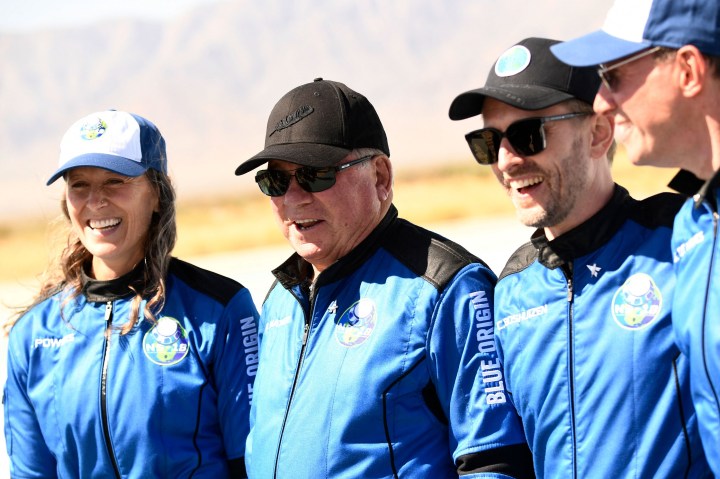
How much will a ticket to space cost?
Share now on:.
- https://www.marketplace.org/2021/10/13/how-much-will-a-ticket-to-space-cost/ COPY THE LINK

Get the Podcast

- Amazon Music
William Shatner was beamed up into space on Wednesday morning, along with three other passengers, as part of Blue Origin’s second launch into space with tourists.
Shatner, who returned with the crew after an 11-minute flight on the New Shepard, became the oldest person to go into space at age 90.
The highly publicized event marks an aggressive push from some companies to enter the realm of commercial space travel. Blue Origin auctioned off a seat on its first spaceflight, which took place back in July and included billionaire founder Jeff Bezos, for $28 million .
Bezos said that the company has sold $100 million in tickets for future flights. Back in 2018, Reuters said that Bezos had planned to charge between $200,000 to $300,000 per ticket for a spaceflight.
Meanwhile, Virgin Galactic said it’s reopened ticket sales for flights a t $450,000 a pop. The spaceflight company, whose billionaire founder Richard Branson also ventured into space in July, has ambitions to open commercial flights next year.
“As we endeavour to bring the wonder of space to a broad global population, we are delighted to open the door to an entirely new industry and consumer experience,” said Virgin Galactic CEO Michael Colglazier in a statement.
The company previously sold tickets for $250,000 each in anticipation for future flights, but suspended sales in 2014 after a test flight crash.
Axiom Space, a private aerospace company that wants to build the first commercial space station, is planning to send private citizens to the International Space Station in 2022 aboard the Crew Dragon from billionaire Elon Musk’s SpaceX. Tickets sold for a whopping $55 million each. Back in 2019, NASA opened up the ISS to private flights.
The market for space tourism
The focus on space flight reflects a broader shift in who the tourism market now caters to.
As the ranks of very wealthy individuals have grown, the middle-class has been priced out of the market, which now focuses more on “exotic luxury,” said Howard McCurdy, a professor of public affairs at American University.
He said, for example, experiences might now consist of taking a trip through the Drake Passage to Antarctica, which can cost tens of thousands of dollars.
“That’s pretty expensive,” McCurdy said. “ It’s not there for everybody, but it is there for a substantial number of people who didn’t exist 40 to 50 years ago in that income category.”
Mark Sundahl, a professor at Cleveland-Marshall College of Law with expertise in space law, said he sees space tourism as a viable industry.
“There’s been a lot of interest and a large number of deposits made by prospective spaceflight participants, as they’re known in the industry, and it’s going to be very popular,” Sundahl said.
But while the rich will be able to afford these tickets, some don’t think space tourism will ever become a mass market opportunity.
“Projections of price and access to space going way back have always been very optimistic. And it’s still very expensive,” said Henry R. Hertzfeld, a professor of space policy and international affairs at George Washington University. “Space is risky — it’s not as easy as it looks when everything goes right.”
The economics of private space companies
McCurdy said he does not think companies like Blue Origin and Virgin Galactic can make money solely flying passengers. To succeed, they’ll have to find other revenue streams.
He pointed to the Air Mail Act of 1925, or the Kelly Act, which allowed private companies to bid for contracts to deliver the mail , which helped financially sustain their operations.
To finance his Blue Origin operation, Bezos said in 2017 that he was selling $1 billion of Amazon stock a year. The company has also partnered with NASA to carry research and technology payloads into space.
In 2020, NASA bega accepting proposals from scientists who wanted to fly with their experiments to space on commercial rockets from companies such as Virgin Galactic and Blue Origin. It offered between $450,00 to $650,000 for their proposals, reported The Verge.
And just last month, NASA awarded $146 million in contracts to five companies, including Blue Origin and SpaceX, to create lander design concepts for its Artemis program (which aims to return astronauts to the moon) and conduct component tests.
“You get the mail, you get some packages, you get some people, and all of a sudden, it starts to make economic sense,” McCurdy said. “And then of course, you charge the people wildly different rates. To be first, to be with Shatner.”
Stories You Might Like
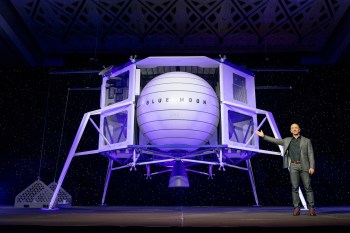
NASA partners with commercial companies to return to the moon
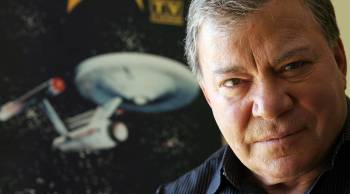
William Shatner is still the captain of his entrepreneurial ship
When bezos and branson head into space, they and their companions fly at their own risk.
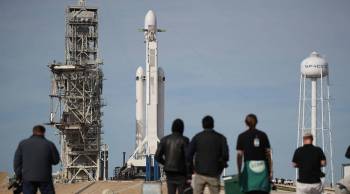
The evolution of the race to the cosmos
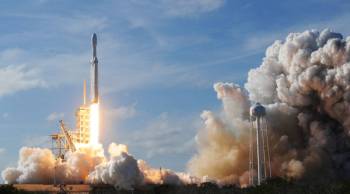
Billionaires will have to duke it out to dominate outer space
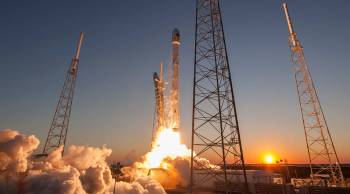
What will be the fallout from SpaceX blast?
There’s a lot happening in the world. Through it all, Marketplace is here for you.
You rely on Marketplace to break down the world’s events and tell you how it affects you in a fact-based, approachable way. We rely on your financial support to keep making that possible.
Your donation today powers the independent journalism that you rely on . For just $5/month, you can help sustain Marketplace so we can keep reporting on the things that matter to you.
Also Included in
- Blue Origin
- Space tourism
- William shatner
Latest Episodes From Our Shows

Why investment in public pools took a dive

At Dollar General, sales of "consumable" goods are up. But profits are down.


Why are there so many adult retailers off of highways?

This is how an Olympian makes money between Games
Things you buy through our links may earn Vox Media a commission.
When Can I Buy a Ticket to Space? A Guide for Non-Billionaires.

We’re at the dawn of a new era for space exploration, with thrill-seeking civilians boldly going where no tourist has gone before. Over 60 years after Soviet cosmonaut Yuri Gagarin became the first person in space, a handful of companies are planning to take non-astronauts with sufficiently massive bank accounts on a galactic tour: Tesla Founder Elon Musk’s SpaceX, Amazon CEO Jeff Bezos’s Blue Origin , and Richard Branson’s Virgin Galactic.
Here’s everything you need to know about the rise of space tourism, from which billionaires are leaving Earth imminently to when the rest of us might be able to join them.
What’s the history of civilian space travel?
The initial effort to send a civilian into space ended in disaster: In 1986, Christa McAuliffe was set to be the first civilian and teacher in space, but she and six crewmates were tragically killed during the explosion of Space Shuttle Challenger.
After that, NASA largely forbade the practice. But Russia’s then-struggling space program stepped up to the plate. On April 28, 2001, Dennis Tito paid a whopping $20 million for a seat on a Russian Soyuz rocket, becoming the first civilian to visit the International Space Station – humanity’s home away from home. According to Space.com , just seven space tourists have followed in his footsteps in the last 20 years, via Russia’s Space Agency. But the year ahead should be a busy one for the nascent industry, with more and more civilians reaching for the stars.
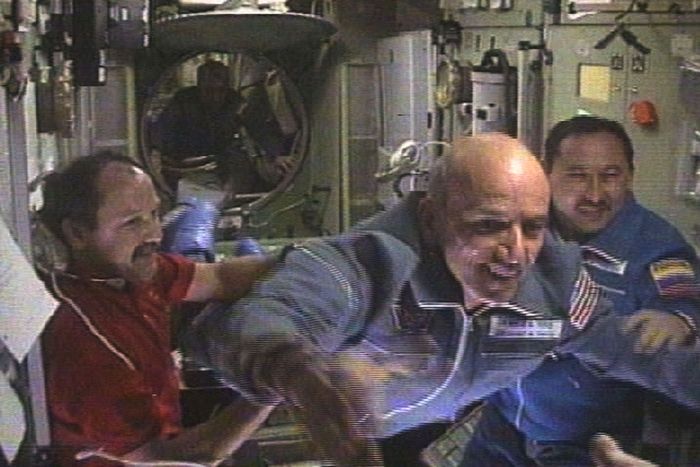
Who’s heading to space next?
The competition between the major players in the billionaire space race heated up when Bezos announced that he would jet off to the brink of space and back on July 20, the anniversary of the Apollo 11 moon landing. On July 1 – just hours after Bezos announced that in addition to his brother, he’d be joined on the flight by aviation pioneer Wally Funk – Richard Branson revealed that he would beat the Amazon founder into space by nine days. Branson will blast off on Virgin Galactic’s VSS Unity rocketplane on July 11.
Elon Musk’s SpaceX is planning what it’s billing as “the world’s first all-civilian space flight” in late 2021. The multiday flight into low Earth orbit, dubbed “Inspiration4” and funded by billionaire entrepreneur Jared Isaacman, aims to raise awareness for St. Jude Children’s Research Hospital and begin “a new era for human spaceflight and exploration.” The crew includes Isaacman, childhood cancer survivor Hayley Arceneaux, plus two others. It’s currently scheduled to launch “no earlier than September 15, 2021,” per the mission’s website.
SpaceX aims to keep the momentum going by partnering with Houston-based Axiom Space to send more everyday people into space using its Crew Dragon spacecraft, this time going to the International Space Station. Axiom’s first private ISS mission is set to launch “no earlier than January 2022.” Its second mission is the focus of the Discovery Channel reality-TV show Who Wants to Be an Astronaut? , in which contestants take on extreme challenges for a chance at a ticket to the ISS. Axiom Space plans to eventually host civilian space station jaunts every six months.
What does this cost?
Unsurprisingly, going to space comes with a hefty price tag. Axiom passengers will pay the low, low price of $55 million for the flight and a stay on the ISS. Meanwhile, Virgin Galactic’s suborbital trips — where passengers can experience weightlessness for several minutes before falling back to Earth — are far more reasonable in cost, at $250,000 . Six hundred people have already made reservations for 90-minute flights on Branson’s SpaceShipTwo, Reuters reports. And while Bezos’s Blue Origin hasn’t announced official prices, an auction for a seat to join him and his brother on his brief sojourn to space in July went for a cool $28 million .
How safe is it?
Hollywood isn’t exaggerating: Going to space is inherently dangerous. Congress agreed in 2004 to largely let the space-tourism industry self-regulate, so there are few laws and restrictions on taking civilians into space.
“One way that the government could have gone was to say, ‘Hey, we’re going to certify the spacecraft, make sure that they’re safe and give them the stamp of approval,’” Mark Sundahl, an expert at space law at Cleveland State University, told Discover magazine . “But they didn’t go that way. Instead, they said ‘We’re going to prove we’re protecting space tourists by just requiring the companies to tell them that they may die, and then it’s up to them to make a decision if they want to take that risk or not.’ That’s the approach that the government took, and it is somewhat controversial.”
What other types of space tourism are in the works?
Strapping in on a rocket and blasting off into space isn’t the only type of travel available for those eager to leave this planet. Human space flight company Space Perspective is planning to fly passengers to the edge of space in a high-tech version of a hot-air balloon, “the size of a football stadium,” lifted by hydrogen. Flights are planned for early 2024, with tickets priced firmly at $125,000 per person.
For another out-of-this-world vacation, check out the company Orbital Assembly Corporation , which plans to open a luxury space hotel in 2027. The hotel, named Voyager Station, looks almost like a Ferris wheel floating in orbit and features a restaurant, gym, and Earth-viewing lounges and bars. A three-and-a-half-day stay is expected to cost up to $5 million, the Washington Post reports.
Are other celebrities planning to explore space?
A slew of stars have already bought their tickets to space with Virgin Galactic, among them Justin Bieber, Ashton Kusher, and Leonardo DiCaprio, according to the New York Daily News . Last year, Actor Tom Cruise and NASA announced their own collaboration to make a movie on the International Space Station.
When can the average person do this?
Once again, the biggest barrier to space is the price tag. But air travel was also once prohibitively expensive, with a one-way ticket across the country costing more than half the price of a new car ; one can expect similar price reductions in space travel. For now, partaking in a sweepstakes or reality show might be the best bet for those with tiny bank accounts and big dreams of taking to the stars.
This post was updated after Branson announced he would head to space on July 11.
- space tourism
- richard branson
- blue origin
- virgin galactic
Most Viewed Stories
- J.D. Vance Blames Staff for Disastrous Doughnut-Shop Visit
- What Trump Said in His Vulgar and Unhinged Truth Social Spree
- The Bitter Feud at the Heart of the Paleontology World
- Donald Trump’s Misogyny Is About Power
- The History of Donald Trump Pretending to Be Superman
- What We Know About the Trump Campaign’s Arlington National Cemetery Incident
Editor’s Picks

Most Popular
- J.D. Vance Blames Staff for Disastrous Doughnut-Shop Visit By Margaret Hartmann
- What Trump Said in His Vulgar and Unhinged Truth Social Spree By Margaret Hartmann
- The Bitter Feud at the Heart of the Paleontology World By Kerry Howley
- Donald Trump’s Misogyny Is About Power By Sarah Jones
- The Shame of Saint Ann’s By Caitlin Moscatello and James D. Walsh
- What We Know About the Trump Campaign’s Arlington National Cemetery Incident By Nia Prater
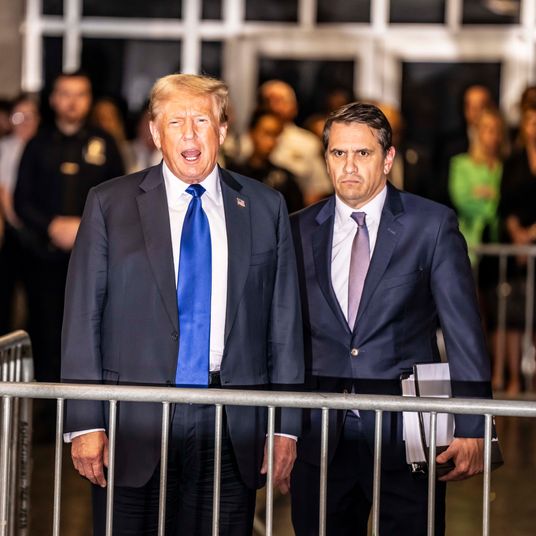
What is your email?
This email will be used to sign into all New York sites. By submitting your email, you agree to our Terms and Privacy Policy and to receive email correspondence from us.
Sign In To Continue Reading
Create your free account.
Password must be at least 8 characters and contain:
- Lower case letters (a-z)
- Upper case letters (A-Z)
- Numbers (0-9)
- Special Characters (!@#$%^&*)
As part of your account, you’ll receive occasional updates and offers from New York , which you can opt out of anytime.

- Promising Startups 2022
- Boarding Pass
- Startup: Confidential
- Appointments
- CTalk
- Tech Gateways
- 2022 VC Survey
- Ctech Testimonials

- Terms Of Use
- Privacy Policy

Space tourism is growing, but only for the rich
Commercial flights into space are becoming more routine, and despite the very high prices, it is estimated that the value of the space tourism industry will reach $3 billion by 2030.
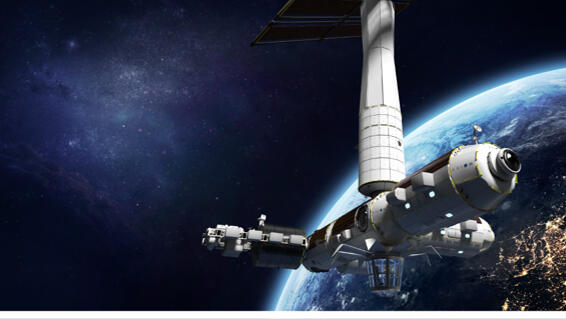
- To infinity and beyond: US and China battling for space supremacy, while India and Japan eye bigger roles
- “It will take some time, but I have no doubt that there will be Israeli space unicorns”
- Star wars: "Israel is interested in space weapons. Every one of our satellites is a machine of war"
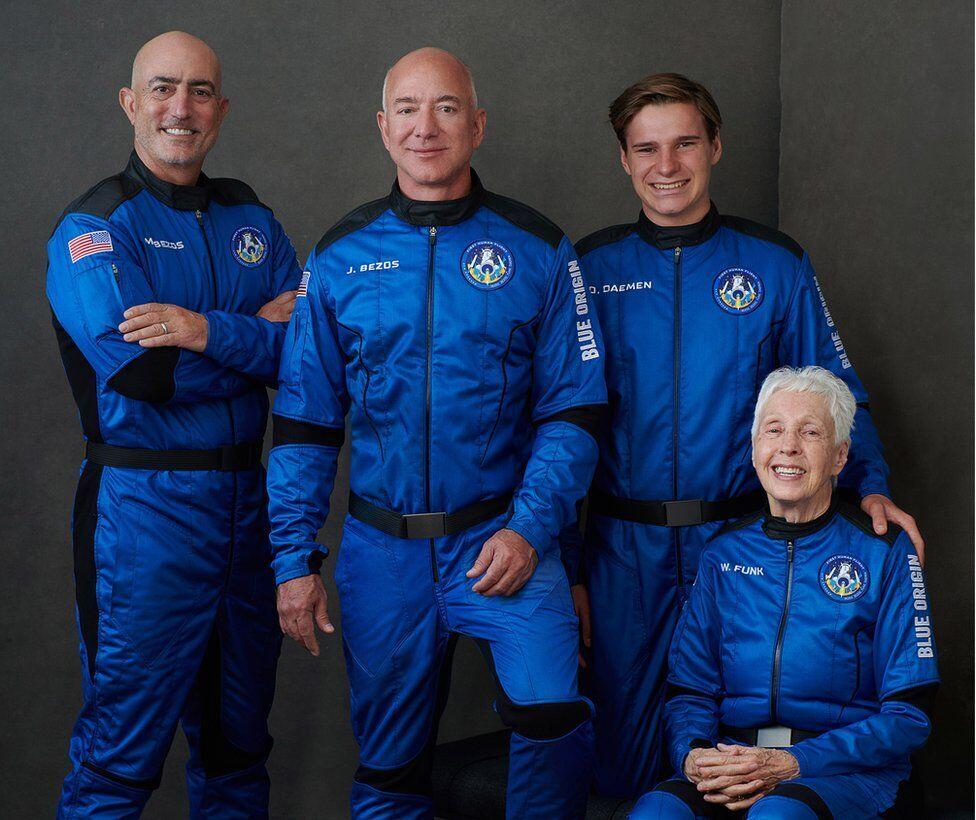
What will space tourists get when they fly with SpaceX, Blue Origin, and Virgin Galactic? Spacesuits, sleeping bags ... and Jeff Bezos
- Virgin Galactic's $250,000 ticket to the edge of space includes a spacesuit.
- Passengers paying $55 million for SpaceX's mission to the ISS get sleeping bags, hygiene products.
- Blue Origin's $28 million spaceflight comes with a seat next to Jeff Bezos.
- See more stories on Insider's business page .

The era of space tourism has dawned.
Richard Branson is scheduled to blast off in Virgin Galactic's VSS Unity on Sunday for the company's first fully-crewed rocket-powered test flight .
If the launch goes ahead as planned, he'll be 9 days ahead of Amazon founder Jeff Bezos, who plans to travel to the edge of space on July 20 in Blue Origin's New Shepard spacecraft.
Meanwhile, SpaceX's private mission with Axiom Space is scheduled to fly four passengers to the International Space Station (ISS) in early 2022.
Read more: As Jeff Bezos and Richard Branson blast off, here are 11 of the most exciting space startups according to VCs
The journeys certainly aren't cheap. Trips aboard Virgin Galactic's VSS Unity will cost passengers $250,000 apiece. A seat on Blue Origin's New Shepard craft was auctioned off at $28 million in June. And the four passengers traveling to the ISS on SpaceX's Crew Dragon will pay a cool $55 million a head.
The question is, what bang will they get for their buck?
SpaceX and Axiom
A ticket for Axiom's mission to the ISS will include:
- Mission planning
- Life support
- Medical support
- Crew provisions
- Eight days aboard the ISS
Staying on the ISS costs the astronauts about $6.8 million a day, NASA told The Verge in January.
According to NASA's 2021 price list , it should cost $2,000 per crew member per day for food and drinks aboard the ISS. It'll also cost each person as much as $1,500 per day for things like clothing, hygiene products, office supplies, and sleeping bags.
Related stories
Blue Origin
The unnamed winner of Blue Origin's auction will accompany Jeff Bezos and his brother on an 11-minute trip on the New Shepard craft. For their $28 million they will be getting:
- On-site accommodation
Blue Origin hasn't yet disclosed commercial seat prices for flights on New Shepard.
Before stepping aboard, passengers must show they can deal with heights, walk on uneven surfaces, and support up to three times their weight, Insider previously reported.
"There are a couple days of training in advance of the flight," a Blue Origin spokesperson told Insider in June. "Some of the training includes learning procedures for getting into and out of the capsule, a mission simulation, and learning techniques for how to move around in zero-g."
Virgin Galactic
Around 600 customers across 58 countries have already forked out up to $250,000 for a seat on Virgin Galactic's Unity spacecraft, which will take them to the edge of space.
A spokesperson from Virgin Galactic told Insider that the ticket includes:
- A spacesuit
Unlike Blue Origin's New Shepard rocket, Unity won't pass the Kármán line, an imaginary boundary between the atmosphere and space. When Virgin Galactic's Unity reaches this height, passengers will experience several minutes of weightlessness before the spacecraft returns to Earth.
Branson, 70, has gone through months of training in preparation for his flight, which is scheduled for July 11.
Watch: How SpaceX, Blue Origin, and Virgin Galactic plan on taking you to space
- Main content

The future of space tourism: op-ed
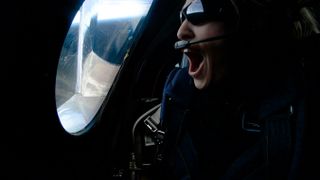
Dylan Taylor is a global entrepreneur, investor and philanthropist who acts as the Chairman and CEO of Voyager Space Holdings and the founder of Space for Humanity , a nonprofit organization that seeks to democratize space exploration. He has also served as an active advocate and philanthropist in the space manufacturing industry and a strategic advisor for the Archmission and the Human Spaceflight Program while also acting as the co-founding patron of the Commercial Spaceflight Federation. He contributed this article to Space.com's Expert Voices: Opinions and Insights .
It's true that 2020 spawned a collective feeling of retreat coupled with a FOMO (fear of missing out) that inspires us to escape a chaotic world. For now, we have the silence of nature or an eventual trip abroad, but the future can provide a more adventurous escape: one to the stars.

The NewSpace industry has its sights set on space tourism , a growing market expected to be worth at least $3 billion by 2030 . As companies like SpaceX test reusable rocket technology to make spaceflight more affordable and accessible for humans, other private firms, including Virgin Galactic and Blue Origin, are investing in suborbital space tourism to take Earthlings into the very edge of space and back. While only uber-wealthy passengers and private researchers will have access to space tourism in the immediate future, the long term holds promises for ordinary citizens.
The evolution of technology plays a vital role in sending more tourists to space and a few influential trends will determine the future of space tourism, along with the progress we make both on and off our home planet.
Related: Space tourists will face big risks, as private companies gear up for paid suborbital flights
Commercial suborbital trips
Suborbital travel will likely be the space tourism subsector to materialize first, but it may also be the most short-lived. However, Blue Origin , backed by Jeff Bezos, is testing its New Shepard system that will launch customers to the edge of space in a capsule which separates from a small rocket and retreats back to Earth under parachutes. Richard Branson's company Virgin Galactic relies on a space plane, dropped from a carrier aircraft, with a rocket motor that speeds up and takes passengers high into the atmosphere.
Both companies' shuttle systems are designed to fly passengers over 50 miles above Earth's atmosphere, allowing customers to experience the feeling of weightlessness for a few minutes. Virgin Galactic's SpaceShipTwo will launch its next human spaceflight test on Dec. 11 as Blue Origin eyes early 2021.
Get the Space.com Newsletter
Breaking space news, the latest updates on rocket launches, skywatching events and more!
These brief spaceflights hold opportunities for tourism and scientific research and present unique experiences for space observation at varying trajectories and regulatory requirements. However, Axios reports concerns over declined public interest in suborbital tourism as a passing interest due to high costs and a short-lived ride. This may deflate the market as passengers await new developments in the field.
But there's some hope. Some experts look to commercial suborbital trips to take the place of long-distance air travel that can eventually cater to everyday citizens. SpaceX plans to use its Starship rocket to fly 100 people around the world in mere minutes. The company stated that a 15-hour flight to Shanghai from New York would be capable of flying in 39 minutes. According to UBS, if even only 5% of the average 150 million passengers that travel on 10 hour or longer flights pay $2,500 per trip, then returns could skyrocket to $20 billion per year in today's value.
A recent UBS report mentions, "Space tourism could be the stepping stone for the development of long-haul travel on earth serviced by space."
Related: Virgin Galactic wants to send people on superfast trips across Earth

Orbital vacations
Orbital tourism, which entails remaining in space for at least one full orbit, is another major focus of governmental agencies and private space companies, all of which have the long-term goal to inhabit the moon and Mars. Projects from Boeing, SpaceX and Axiom Space plan to start launching tourists to the International Space Station on commercial spacecraft beginning as early as this year. SpaceX is also partnering with Space Adventures to send four tourists to low Earth orbit for a few days in late 2021 or early 2022.
As more companies consider in-space tourism, orbital vacations are set to become a popular trend. Orbital vacationing infrastructure, including orbital and lunar-based hotels, is positioned to become lucrative as space infrastructure companies already hauled in a combined $3.6 billion so far this year .
Much of this infrastructure remains in preliminary stages, but the first approach may be to establish low-orbit hotels. One hotel design expects to send guests in a hydrogen-filled balloon with a pressurized capsule, utilizing Earth's gravity. Other options include designing or renovating an existing space station to accommodate guests. NASA, for instance, is opening up the International Space Station for commercial tourism . The Aurora Station , a planned luxury hotel that will host six guests for a $9.5 million, 12-day stay in low Earth orbit, will charge $9.5 million for the trip. It's pricey, but experts predict prices will fall like they did in the tech industry for computers and mobile phones.
A proposal for expandable space habitats may also serve as orbital hotels. Made of unique materials and easily stored at home, they are launched to space where they're inflated to true size. Bigelow Space invented the B330 , a space habitat that enlarges to form a hotel or living area for humans in space. As demand increases, they are interconnected to other inflatable habitats to increase their size. Bigelow also plans to develop an attached inflated module to the International Space Station as one of the first hotels in space. In-space vacations will eventually be the gateway for moon and Mars habitation.
Nurturing the space and world economies
Private space companies are devotedly investing across space tourism and firms like UBS consider access to space an enabler to broader opportunities for investment.
More next-generation engineers will enter the space tourism sector for the scope of opportunities and innovation, eventually decreasing the barriers to entry that will increase competition, lower costs, and ultimately democratize space travel for everyday citizens.
Of course, there are crucial safety, comfort and health factors to consider. Training, medical screenings and liability waivers will need to be examined before tourists head to space.
Space tourism will be a small subsector of the industry, but it will bolster the entire NewSpace industry. Once space tourism does become mainstream, it will also positively impact many socioeconomic factors on Earth: creating jobs, educating citizens about space and fostering a new solar-based energy infrastructure. The sweet escape to the stars can eventually awaken us to the awe-inspiring potential of space exploration while also giving us a better appreciation of home.
Follow us on Twitter @Spacedotcom and on Facebook.
Join our Space Forums to keep talking space on the latest missions, night sky and more! And if you have a news tip, correction or comment, let us know at: [email protected].
FAA requires investigation into SpaceX Falcon 9 landing failure
SpaceX rocket catches fire, falls over while landing at sea after record-breaking Starlink launch (video)
Astronaut John McFall carries Paralympic flag at opening ceremony Aug. 28
Most Popular
- 2 FAA requires investigation into SpaceX Falcon 9 landing failure
- 3 Mock shuttle Pathfinder restored atop its stack at Alabama rocket center (photos)
- 4 Japan declares its SLIM moon lander dead at last
- 5 SpaceX rocket catches fire, falls over while landing at sea after record-breaking Starlink launch (video)
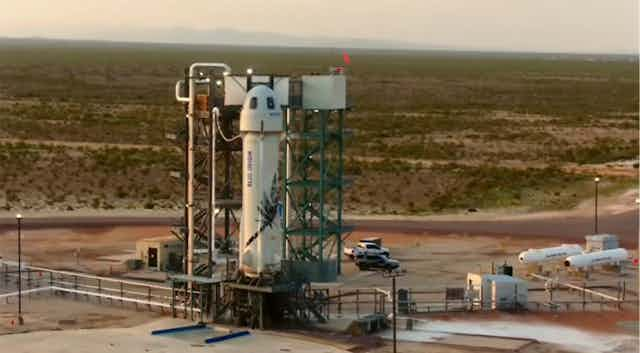
Keen to sign up for space tourism? Here are 6 things to consider (besides the price tag)
Professorial Fellow, Bond University / Emeritus Professor of International Law, Western Sydney University, Western Sydney University
Disclosure statement
Steven Freeland is a Director of the International Institute of Space Law
Western Sydney University provides funding as a member of The Conversation AU.
View all partners
It’s been a momentous month for space-faring billionaires. On July 11, British entrepreneur Sir Richard Branson’s Unity “rocket-plane” flew him and five fellow passengers about 85 kilometres above Earth. And this week, Amazon founder Jeff Bezos’ New Shepard capsule reached an altitude of 106km , carrying Bezos, his brother, and the oldest and youngest people ever to reach such a height. Passengers on both flights experienced several minutes of weightlessness and took in breathtaking views of our beautiful and fragile Earth.
Both flights created an avalanche of media coverage and brand recognition for Branson’s Virgin Galactic and Bezos’s Blue Origin. There is renewed anticipation of a lucrative commercial space tourism industry that could eventually see thousands of paying passengers journey into space (or not quite into space, depending on your preferred level of pedantry).
This year marks 60 years since Soviet cosmonaut Yuri Gagarin became the first human in space. Since then, almost 600 trained astronauts have gone into outer space, but very few people have become space tourists.
The first, US engineer Dennis Tito, paid a reported US$20 million to spend six days orbiting Earth in the Russian section of the International Space Station in April 2001, after three months’ training at Russia’s Star City complex. He was followed by a handful of other very wealthy “orbital tourists”, most recently Cirque de Soleil founder Guy Laliberté in 2009, whose ticket reportedly cost US$35 million.
Unlike their predecessors, Branson’s and Bezos’ flights were suborbital – they didn’t reach the velocity needed to orbit Earth. Bezos’s entire flight lasted just over 10 minutes. Suborbital flights are much less technically complex, and in theory cheaper (although one seat on the New Shepard flight was auctioned for US$28 million ).
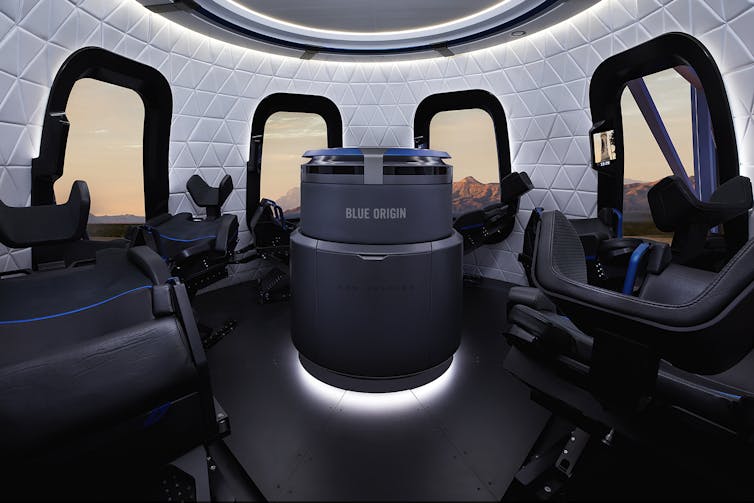
While they might quibble over billionaire bragging rights, there’s no denying that suborbital “space” flights have the potential to be less eye-wateringly expensive than going into orbital outer space and beyond.
But before you sign up – assuming you’re lucky enough to afford it – here are a few things to consider.
Where does space start, anyway?
Despite assertions to the contrary , there is no legal definition of “outer space”, and thus no official boundary where airspace ends and outer space begins. In the past, the International Aeronautical Federation has looked to the von Karman line , but this does not coincide with the boundary of any of the atmosphere’s scientifically defined layers, and the UN Committee on the Peaceful Uses of Outer Space , which deals with such issues, has not yet resolved the question.
Conveniently for Branson, 80km has been proposed by some experts as an appropriate boundary.
Outer space is undeniably influenced by Earthly geopolitics. Essentially, the larger space-faring countries see no need to legally define a boundary that would clearly demarcate the upper limits of their sovereignty.
Will you be an ‘astronaut’?
The 1967 UN Outer Space Treaty designates astronauts as “envoys of (hu)mankind in outer space”. Certainly, that seemed to be the case as the world watched the historic Apollo 11 Moon landing and prayed for a safe return of the stricken Apollo 13 capsule. However, the 1968 UN Rescue Agreement refers to “personnel of a spacecraft”, which may imply not everyone on board should be considered a fully fledged astronaut.
Of course, these legal niceties won’t deter space tourism companies from awarding “astronaut wings” to their passengers.

What laws apply when things go wrong?
The 1986 Challenger and 2003 Columbia shuttle disasters are stark reminders of the dangers of space travel. Human space travel has always involved determining acceptable levels of risk for trained astronauts. But commercial space tourism is different to state-sponsored space programs, and will need the highest possible safety standards.
Commercial space travel will also require a system of responsibility and liability, for cases in which a space tourist suffers injury, loss or damage.
Space tourists (or their families) can’t claim for compensation under the 1972 UN Liability Convention which, in terms of space, applies only to collisions between space objects such as satellites and space debris. While there may be scope to take legal action under national laws, it is likely space tourists will be asked to sign carefully worded waivers of liability.
Read more: Want to become a space tourist? You finally can — if you have $250,000 and a will to sign your life away
The same is probably true of international air law , which applies to “aircraft” — a designation space tourism operators will understandably be keen to avoid.
Ultimately, we may need to develop a system of “aerospace law” to govern these suborbital flights as well as “transorbital” transport such as the keenly envisaged flights that might one day take passengers from Sydney to London in just a few hours.
What activities should be allowed in space?
The advent of space tourism will give rise to some interesting ethical questions. Should there be advertising billboards in space? What about casinos, or brothels? On what legal basis should these things be restricted?
How does tourism fit with the underlying philosophy of space law: that the exploration and use of outer space “shall be carried out for the benefit and in the interests of all countries”?
Will space tourism harm the environment?
Space tourism will inevitably put pressure on Earth’s environment – there are claims that space vehicles may one day become the world’s biggest source of carbon dioxide emissions. We will need to manage space traffic carefully to avoid disastrous collisions and steer clear of space debris .
Read more: It's not how big your laser is, it's how you use it: space law is an important part of the fight against space debris
If tourists go to the Moon, they may cause pollution or damage the heritage of earlier exploration, such as Neil Armstrong’s footprints .

Will tourism workers have to live in space?
If space tourism does become truly widespread, it will need infrastructure and perhaps even staff. People may end up living permanently in space settlements, perhaps having children who will be born as “space citizens”. What legal rights would someone have if they were born at a Moon base? Would they be subject to terrestrial laws, or some version of current international legal rules for outer space?
These are obviously questions for the future. But given the excitement generated by the brief journeys of a couple of wealthy entrepreneurs, we should start contemplating them now. Outer space is the new frontier, but it is not — and must not — be a lawless one.
- Sustainability
- United Nations
- Space tourism
- Space debris
- Richard Branson
- Virgin Galactic
- Blue Origin
- Space treaties
- Suborbital flight

Director of STEM

Community member - Training Delivery and Development Committee (Volunteer part-time)

Chief Executive Officer

Finance Business Partner

Head of Evidence to Action
- Travel, Tourism & Hospitality ›
Leisure Travel
Space tourism - statistics & facts
What is the public’s opinion on space tourism, do the public want to travel to space, key insights.
Detailed statistics
Global sub-orbital space tourism market size 2021-2031, by flight vehicle type
Amount invested globally into space companies by venture capitalists 2013-2022
Equity investments in space companies worldwide 2013-2022, by type
Editor’s Picks Current statistics on this topic
Travel, Tourism & Hospitality
Forecast revenue of orbital space travel and tourism worldwide 2021-2030
Share of U.S. adults who want to travel to space 2021
Further recommended statistics
Market overview.
- Premium Statistic Global sub-orbital space tourism market size 2021-2031, by flight vehicle type
- Premium Statistic Forecast revenue of orbital space travel and tourism worldwide 2021-2030
- Premium Statistic Amount invested globally into space companies by venture capitalists 2013-2022
- Premium Statistic Equity investments in space companies worldwide 2013-2022, by type
- Premium Statistic Share of investment deals in space start-ups worldwide by company in 2020
- Premium Statistic Distribution of space start-up investors by type 2000-2020
Sub-orbital space tourism market size worldwide in 2021, with a forecast for 2031, by flight vehicle type (in million U.S. dollars)
Forecast revenue of the orbital space travel and tourism market worldwide from 2021 to 2030 (in million U.S. dollars)
Amount venture capitalists invested into space companies worldwide from 2013 to 2022 (in billion U.S. dollars)
Cumulative equity investment in space companies worldwide from 2013 to 2022, by type (in billion U.S. dollars)
Share of investment deals in space start-ups worldwide by company in 2020
Distribution of investment deals on space start-ups worldwide in 2020, by company
Distribution of space start-up investors by type 2000-2020
Distribution of investor groups in space start-ups from 2000 to 2020, by investor type
Public opinion
- Premium Statistic U.S. public opinion on which private space companies are leading the space race 2021
- Premium Statistic U.S. opinion on which private space companies are leading the space race 2021, by age
- Premium Statistic Share of U.S. adults that believe space travel should be accessible to everyone 2021
- Premium Statistic U.S. public opinion on profitability of space exploration companies in future 2021
- Premium Statistic U.S. adults that believe billionaires should spend money on space travel 2021
U.S. public opinion on which private space companies are leading the space race 2021
Public opinion on which space companies are leading the private sector's push into space in the United States as of December 2021
U.S. opinion on which private space companies are leading the space race 2021, by age
Public opinion on which space companies are leading the private sector's push into space in the United States as of December 2021, by generation
Share of U.S. adults that believe space travel should be accessible to everyone 2021
Share of adults that believe space travel should be accessible to everyone and not just those that can afford the costs in the United States as of September 2021
U.S. public opinion on profitability of space exploration companies in future 2021
Share of the public that believe private companies focused on space exploration will make a profit in the next 10 years in the United States as of December 2021
U.S. adults that believe billionaires should spend money on space travel 2021
Share of adults that believe billionaires should be spending money traveling to space in the United States as of September 2021
Traveler interest
- Premium Statistic Share of U.S. adults who want to travel to space 2021
- Premium Statistic Share of U.S. adults who want to travel to space 2021, by gender
- Premium Statistic Share of the U.S. public who would go to the moon if money was not a factor 2021
- Premium Statistic Share of the U.S. public who would go to the moon in 2021, by generation
- Premium Statistic Share of the U.S. public who would go to the moon in 2021, by gender
- Premium Statistic Share of U.S. adults who would travel to the moon 2021, by age
- Premium Statistic Share of U.S. adults who would spend over 100 thousand USD to travel to space 2021
Share of adults that would want to travel to space if money was not an issue in the United States as of September 2021
Share of U.S. adults who want to travel to space 2021, by gender
Share of adults that want to travel to space if money was not an issue in the United States as of September 2021, by gender
Share of the U.S. public who would go to the moon if money was not a factor 2021
Share of the public that would go to the moon as a tourist if money was not a factor in the United States as of December 2021
Share of the U.S. public who would go to the moon in 2021, by generation
Share of the public that would go to the moon as a tourist if money was not a factor in the United States as of December 2021, by generation
Share of the U.S. public who would go to the moon in 2021, by gender
Share of the public that would go to the moon as a tourist if money was not a factor in the United States as of December 2021, by gender
Share of U.S. adults who would travel to the moon 2021, by age
Share of adults that would travel to the moon in the United States as of May 2021, by age
Share of U.S. adults who would spend over 100 thousand USD to travel to space 2021
Share of adults that would spend more than 100 thousand U.S. dollars to travel to space in the United States as of September 2021
Further reports
Get the best reports to understand your industry.
- European aerospace industry
- Space industry worldwide
- Space tourism
Mon - Fri, 9am - 6pm (EST)
Mon - Fri, 9am - 5pm (SGT)
Mon - Fri, 10:00am - 6:00pm (JST)
Mon - Fri, 9:30am - 5pm (GMT)
UNC student Karsen Kitchen becomes youngest woman to achieve space milestone

CHAPEL HILL, N.C. (WTVD) -- A UNC student achieved one of her lifelong goals Thursday morning by going into space.
Karsen Kitchen, 21, was one of six crew members for Blue Origin's New Shepard 26 flight, which launched around 9 a.m.
The flight took just over 10 minutes launching the crew at a maximum velocity of 2,238 miles per hour.
The crew experienced zero gravity for more than a minute and then the capsule returned back to Earth safely.
Kitchen said going to space has been a dream of hers for years.
"I have so many memories of going out side when I was younger, looking up at the night sky. I would come in and be like 'Y'all, I want to be an astronaut,'" Kitchen said. "I feel so grateful and It feels unreal. I still feel like I really haven't processed it all."
What's even more incredible is that Kitchen's flight made her the youngest woman to ever cross the Karman Line, which is the border between the Earth's atmosphere and outer space.
I'm doing this for all the young women out there that think that they can't do it. Karsen Kitchen
Kitchen is a senior at UNC. She also previously interned with Blue Origin, a commercial space flight company and manufacturer founded by Amazon's Jeff Bezos. She also previously worked at UNC's UNC's Morehead Planetarium for a summer and recently founded a new initiative to encourage women to seek careers involving space called Orbitelle.

"I'm doing this for all the young women out there that think that they can't do it. Who think that can't have a job in space. I want to inspire as many people as I possibly can," Kitchen said.
She is the youngest woman to cross the Karman Line, but she's not be the first person in her family to do it. Kitchen's father, Jim Kitchen (who is a professor at UNC), was a passenger on the New Shepard 20 flight in 2022.
He was on the ground to greet her when she returned to Earth. They shared a terrestrial hug and will forever share the memories of leaving Earth's atmosphere.

Related Topics
- CHAPEL HILL
Top Stories

1 dead after car crashes, catches fire on I-40

Saturday partly sunny; weekend could bring more rain

Food Lion recalls ground beef from Nash County store

Labor Day: travel tips, best times to leave, gas prices

Canes sign Seth Jarvis to 8-year contract
- 3 hours ago
How NC decides who appears first on your ballot
Robinson's controversial history may impact Trump's efforts to win NC
RFK Jr. sues NC elections board to get name off ballot

IMAGES
VIDEO
COMMENTS
Evolution of Spaceflight Costs and Technologies. During the space race, the cost of sending something into space averaged between $6,000 to over $25,000 per kg of weight not adjusted for inflation and NASA spent $28 billion to land astronauts on the moon, about $288 billion in today's dollars. In recent decades, it has averaged around $10,000 ...
Price: $125,000. Flight altitude: 30 kilometers. What you'll get: A relaxing six-hour ride to the stratosphere in a balloon-borne pressurized capsule. Date available: 2024. Value for money ...
Space tourism industry could be worth $2.7 trillion by 2040 but many will travel for free says report. ... It's rumoured that Blue Origin could ask $500,000, though prices aren't yet known.
For now, the most significant barrier for space tourism is price. But air travel was also once expensive; a one-way ticket cost more than half the price of a new car. Most likely, the price for space travel will reduce overtime as well.
The pros of space tourism. A handful of private individuals, colloquially known as space tourists, managed to purchase tickets to the ISS or Russia's Mir station.
Companies offering balloon rides over rocket launches can offer space tourism experiences at lower prices. A voyage with World View will cost $50,000 a ticket and they have "flexible financing ...
Each spot on Virgin's suborbital spaceplane, the cheapest way to space at the moment, will set somebody back $450,000. A single seat on Blue Origin's initial suborbital launch sold at auction ...
How much does it cost to go into space? It depends, says McAlister. For a trip on Virgin Galactic's SpaceShipTwo and Blue Origin's New Shepard, seats typically cost $250,000 to $500,000.
Oct. 13, 2021. Blue Origin has declined to publicly state a price for a ticket to fly on New Shepard. The company is nearing $100 million in sales so far, Mr. Bezos has said. But it's unclear ...
The market for space travel (and the sky-high prices that come with it), he believes, will evolve much like civilian air travel did. "In the beginning of the 20th century, only very affluent ...
Price: $200,000 and $300,000. Earliest available time: unknown. Blue Origin, owned by Amazon CEO Jeff Bezos, is developing a suborbital tourism program similar to Virgin Galactic's but using a ...
It marks a new era in space tourism for the company, with monthly flights expected to follow. Space tourism is a growing industry for the rich. Seats on a Virgin Galactic flight cost $450,000 each.
Back in 2018, Reuters said that Bezos had planned to charge between $200,000 to $300,000 per ticket for a spaceflight. Meanwhile, Virgin Galactic said it's reopened ticket sales for flights a t ...
Here's a guide to the rise of space tourism, including the price, the danger, and when the average person can head to the stars. ... Congress agreed in 2004 to largely let the space-tourism ...
Commercial flights into space are becoming more routine, and despite the very high prices, it is estimated that the value of the space tourism industry will reach $3 billion by 2030 Lital Samet 09:08, 01.10.23
The space tourism tickets will cost a total of $450,000 for the 90-minute flight, including an initial $150,000 deposit, and will be available for purchase on Virgin Galactic's website. The ...
Virgin Galactic's $250,000 ticket to the edge of space includes a spacesuit. Passengers paying $55 million for SpaceX's mission to the ISS get sleeping bags, hygiene products. Blue Origin's $28 ...
The NewSpace industry has its sights set on space tourism, a growing market expected to be worth at least $3 billion by 2030. ... but experts predict prices will fall like they did in the tech ...
You finally can — if you have $250,000 and a will to sign your life away. Read more: It's not how big your laser is, it's how you use it: space law is an important part of the fight against ...
The space tourism market has remained nascent for the past two decades, but a handful of companies are looking to change that.
The total ticket price is $450,000 with an initial deposit of $150,000, largely refundable, except for a $25,000 Future Astronaut Community Access fee. The company's first Virgin Galactic space ...
Space tourism is human space travel for recreational purposes. [1] ... The publicized price was in the range of US$20-25 million per trip. Some space tourists have signed contracts with third parties to conduct certain research activities while in orbit. By 2007, ...
The estimated revenue of the orbital space tourism market worldwide amounted to roughly 385 million U.S. dollars in 2021, and this figure was forecast to reach 555 million U.S. dollars by 2030 ...
Kitchen said going to space has been a dream of hers for years. ... Labor Day: travel tips, best times to leave, gas prices. Data shows 13 to 17-years-old most frequent callers of 988 Hotline.